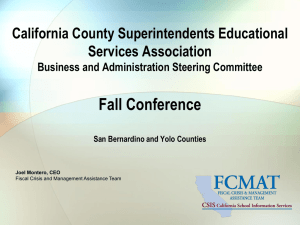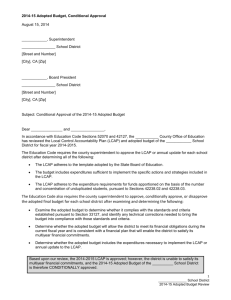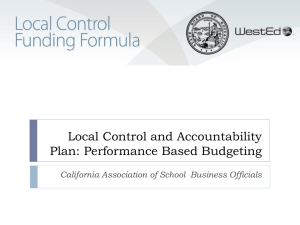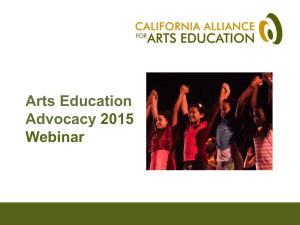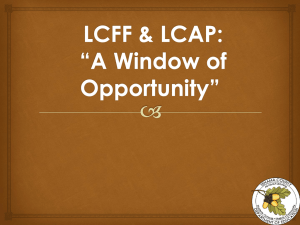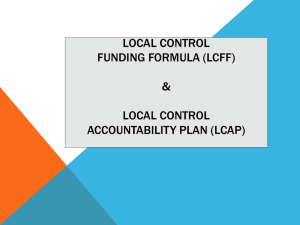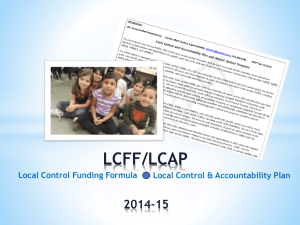presentation slides - California School Boards Association
advertisement
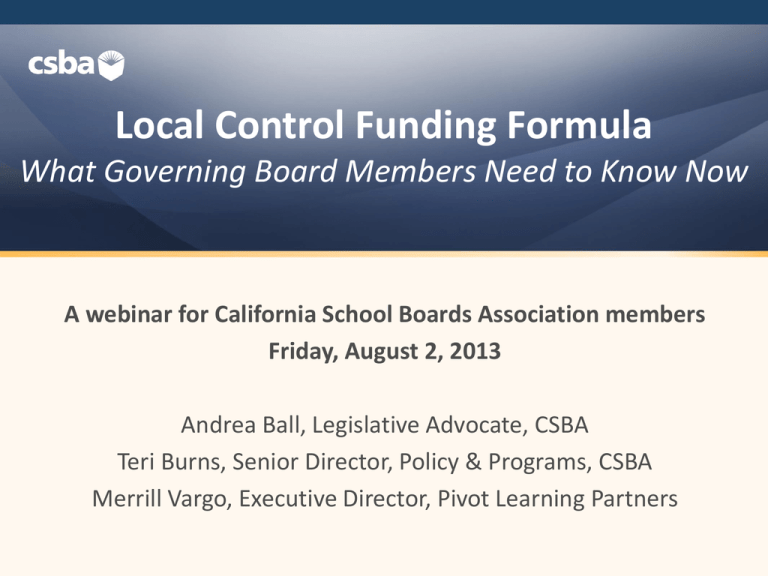
Local Control Funding Formula What Governing Board Members Need to Know Now A webinar for California School Boards Association members Friday, August 2, 2013 Andrea Ball, Legislative Advocate, CSBA Teri Burns, Senior Director, Policy & Programs, CSBA Merrill Vargo, Executive Director, Pivot Learning Partners Goals Introductions and Outline of Goals for the webinar • • • Inform members and identify key issues Provide tools and resources for Governing Board Members Help local education agencies successfully implement Local Control Funding Formula What CSBA is doing to help Governing Board Members • • • • • • • Today’s webinar Governance Briefs, Fact Sheets, Frequently Asked Questions Back to School Webcast on September 10, 2013 Annual Education Conference, December 5-7, 2013, San Diego Newsletters, Weekly e-blasts Revising sample policies Engage CSBA Discussion Forum and LCFF site on webpage Agenda 1. 2. 3. 4. 5. 6. Overview & Key Dates The Formula Accountability Plans What Boards Can Do Now Opportunities and Challenges Q&A Local Control Funding Formula (LCFF) Major Restructuring of School Finance Formula Based on considerations of: • Equity, additional resources for students with greater needs. Three LCFF subgroups: low-income students, English learners, students in foster care. • Local decision-making and stakeholder involvement • Accountability • Transparency • Alignment of budgeting with accountability plans. 4 LCFF Key Dates • January 2014 State agencies update standards for adoption of local budgets o State Board adopts regulations on expenditure of supplemental and concentration funds o Changes recommended to revise the Academic Performance Index o • March 2014 o State Board adopts template for Local Control and Accountability Plans (LCAPs) • June 2014 Local educational agencies have established local policies to implement o Local educational agencies adopt LCAP aligned with budget o • October 2015 o State Board adopts rubrics for evaluation and technical assistance 5 LCFF Begins 2013-14 • Instead of funding based on revenue limits and categorical programs, districts are provided: o Base grants, differentiated by grade spans and K-3 class size of 24:1 (+10.4% of the base) Grades 9 -12 (+2.6% of grade span base) o Statewide Average Base Grant Target: $7,643. Base target to get virtually all districts to 2007-08 funding levels. o Full implementation expected by 2020-21 • Supplemental funding and concentration funding based on unduplicated counts of pupils in specified subgroups: Lowincome; English learners; Foster youth. 6 LCFF Economic Recovery Targets Economic Recovery Targets (ERT): • The ERT is provided to districts who would have received greater level of funding under “old” system of revenue limits and categoricals than under LCFF. • Provides districts with the greater of LCFF target or ERT. • Districts to receive 1/8 of the amounted needed to reach ERT, each year for next 8 years (LCFF implementation) • Districts ineligible for ERT if their per pupil funding rate under old system exceeds the 90th percentile of per pupil funding rates under the old system. (See LAO Report pp. 5 – 6) 7 LCFF Rules on specific programs • Home-to-School Transportation and Targeted Instructional Improvement Grants as add-ons: o o Districts will continue to receive 2012-13 levels Transportation funds used for transportation. • Adult Education and Regional Occupational Centers and Programs: o Maintenance of effort requirements for two years. • Joint Powers Authorities for Transportation or ROC/Ps: Districts must continue for two years. 8 County Offices of Education Formula Two-part formula: A. Oversight operational grants o Minimum grant per county and o Number of school districts in the county o ADA in the county attributable to school districts, charter schools and schools operated by the county superintendent . 9 County Office formula (cont.) B. Second part of formula based on category of pupil served: • • • Under authority of juvenile justice system; probationreferred; on probation; mandatorily expelled. Supplemental grant: 35% of base Concentration grant: 35% of base for targeted students exceeding 50% of enrollment. 10 District Supplemental and Concentration Funds • Supplemental funds of 20% of the base grant as adjusted for K-3 and 9-12. o Based on unduplicated counts of pupils in three specified subgroups • Concentration funds o o Districts with enrollment over 55% of students in the three specified subgroups 50% of the base grant, generated based on unduplicated counts of students above 55% of district enrollment 11 Local Control Funding Formula & Student Counts • Student subgroups • 30 or more minimum o English learners o Low income defined as eligible for free or reduced price meals (F/RPM) • Students in foster care (new subgroup & 15 minimum) • Counts based on three-year rolling averages • Districts report via California Longitudinal Pupil Achievement Data System (CALPADS) • Data verified by COEs and reports included in district audits 12 Expenditure Details Supplemental & Concentration Funds • To increase or improve services for English Learners, Lowincome students (defined as eligible for F/RPM) and students in foster care in proportion to the increase in funds apportioned on the basis of the number of unduplicated counts of these students; • The district may use these funds for schoolwide, districtwide, countywide purposes in a manner that is no more restrictive than the restrictions provided for in Title I of the No Child Left Behind Act of 2001. • State Board of Education to adopt regulations by January 31, 2014 to govern use of these funds. 13 LCFF and Local Control & Accountability Plans (LCAPS) Local education agencies (LEAs) must adopt three-year LCAPs; first one to be adopted by July 1, 2014. • Plans must be aligned to LEA budget and describe: o o Annual goals for all pupils and each subgroup to be achieved for each of the state priorities identified in statute and any additional local priorities identified by the local governing board; Specific actions the LEA will take during each year to achieve those goals. • LEAs to conduct annual updates and review of progress in meeting goals 14 LCFF Details State Priorities • Degree to which: teachers are fully credentialed & appropriately assigned, students have sufficient instructional materials, and facilities are in good repair (Williams priorities) • Implementation of content standards (CCSS), including ELD • Parental involvement, including efforts to seek input & participation • Student achievement measured by: state assessments, API, A-G & CTE, EL proficiency & reclassification, AP exam scores of 3 or higher, college readiness (Early Assessment Program) • Student engagement: attendance, absenteeism, dropout/graduation • School climate: suspension/expulsion rates, other local measures • Student access to broad course of study as described in Ed Code • Pupil outcomes in subject areas specified for grades 1- 6 and 7-12 15 LCAP Process: Transparency & Involvement Governing Boards • Consult with teachers, principals, administrators, other school personnel, parents and pupils in developing LCAP. • Establish Parent Advisory Committee to provide advice to board and superintendent on LCAP requirements; • Establish an English Learner Parent Advisory Committee if district English learner enrollment is at least 15% and 50 pupils. 16 Transparency & Public Process Similar to process and timeline on budget adoption • Hold at least one public hearing to solicit recommendations and comments from the public. • Hold the public hearing at same meeting as the public hearing required on the district budget. • Adopt the LCAP in a public meeting. The meeting shall be held after and not on same day as hearing. • The governing board may adopt revisions to the LCAP during the period the LCAP is in effect. Revisions must be adopted via procedure noted above. 17 Transparency (cont.) • Approved LCAPs to be posted on district websites • Links to LCAPs posted on county office websites and o State Superintendent to post links to LCAPs on Department of Education website. • Complaints of noncompliance with LCAP requirements via Uniform Complaint Process o Appeals to State Superintendent • Districts, county superintendents, charter schools to establish local policies to implement LCAP by June 30, 2014. 18 LCAP Process The district must file LCAP with county superintendent. • County superintendent shall approve LCAP if he/she determines both of the following: o o LCAP adheres to template adopted by State Board of Education District’s budget includes expenditures sufficient to implement actions and strategies in LCAP. • Clarifications? Governing board responds in writing. • Recommended amendments? Governing board considers in public meeting • If the county superintendent does not approve a district's LCAP, the county superintendent shall provide technical assistance. Statutory provisions on technical assistance. 19 LCAP and Districts in need of Intervention State Superintendent of Public Instruction with approval of State Board of Education The SPI may, with the approval of the SBE, identify school districts in need of intervention. The SPI shall only intervene in a district that meets both of the following: 1) The district did not improve the outcomes for three or more pupil subgroups in regard to more than one state or local priority in three out of four consecutive school years. 2) The California Collaborative for Education Excellence has provided advice and assistance to the district and submits either of the following findings to the SPI: A) that the district failed or was unable to implement recommendations; B) the inadequate performance of the district is so persistent or acute as to require intervention by the SPI. 20 Evaluating strengths and weaknesses, need for technical assistance • The State Board of Education is to adopt evaluation rubrics that reflect a “holistic multidimensional assessment” of district and schoolsite performance and that include all of the state priorities. SBE to adopt rubrics by October 1, 2015. Rubrics are to: • Assist a district, county office of education, or charter school in evaluating its strengths, weaknesses and areas that need improvement. • Assist a county superintendent in identifying school districts and charter schools in need of technical assistance. • Assist the State Superintendent in identifying school districts for which intervention is warranted. 21 What Boards Can Do Now • Hold public study sessions to review LCFF and especially sections on LCAPs • Establish district-wide committees • Examine and understand district data o Pupil data, financial data, current use of resources data • Set district goals and strategies for subgroup improvement • Be patient. Many of the rules will follow – don’t lock your budget into long-term commitments that might not let you comply. • Start your budget planning process for the next year now. 22 Key Questions for Governance Teams • What budget adjustments do we need to make now to comply with maintenance of effort requirements? • What is the status of our district parent advisory committees? • How can we best educate ourselves and our community about our student data? • What is our confidence level in our data? 23 The Local Control Funding Formula: Opportunities and Challenges for Local Education Leaders A New Day Local Control Funding Formula (LCFF) will… 1. Increase local flexibility and redefine accountability 2. Prompt new levels of budget transparency and community engagement 3. Align planning with budgeting and use plans to tie resources to students. 4. Support new levels of innovation in their districts. 25 Many details remain to be worked out: The State Board has been charged with developing a template for the new Local Control Accountability Plan (LCAP). This will be available in early 2014. But Boards can and should start now by navigating by the big ideas behind LCFF. 26 The LCFF Big Ideas reflect lessons from experiments in local finance reform: • Pivot Learning Partners’ “Strategic School Funding for Results” project: • Partnered to launch district-level finance reform in two districts: Los Angeles and Twin Rivers Unified School Districts • American Institute for Research (AIR) was research partner • Lessons from this project influenced new state policy and shape the recommendations that follow. 27 Boards can seize the LCFF opportunity by: • Adopting goals: Board goals are the tools to shape spending priorities. • Revising the budget development calendar: Budget development will need to start in the fall to connect planning with budgeting. • Engaging the community: Communities will need to help identify and prioritize strategies to meet the goals. 28 The new plan – the LCAP – will align Planning with Budgeting Past: Plans follow budgets Reactive Future: Plans Drive Budgets Proactive The Governor proposes a budget in January; districts calculate what schools will receive. The planning cycle for the next school year begins in the fall, before the budget is fixed Schools and districts develop and adopt a budget quickly, in a reactive mode Planning begins with a review of data There is not sufficient time to build community buy-in for the plan The longer planning cycle allows time for community engagement Schools then completing the SPSA for compliance reasons Goals and priorities are in place and shape how resources are allocated when details become available 29 What an aligned planning and budgeting process looks like Implement Develop goals, priorities Begin implementation of school and district plans • Training and PD calendar for staff • Continue to engage community on implementation • • Summer • Fall Review data, assess community needs Revisit district, school goals , revise and adopt Identify and prioritize strategies and activities. Ongoing stakeholder engagement and data analysis Finalize school plans • • • Spring Layoff notices (if needed) Review budget and school site plan with stakeholders Submit school plan for final School Board approval Winter Budget developed • • • • • l Identify resources Fund high priority strategies Submit LCAP, budget to COE Gain consensus with stakeholders on school budget Finalize staffing decisions 30 “He who fails to plan is planning to fail.” Winston Churchill LCFF will empower Boards to ask important new questions: • What level of investment are we making in each of our goals? • What level of investment are we making in each of our target student populations? • What level of investment are we making in each of our schools? • Are we investing the right amounts in the right places? How would we know? 31 New Roles for Software: One Example of a 21st Century Solution Ties Funding to Explicit and Measurable Goals Promotes Cross-School Collaboration Encourages Site-Level Innovation in Support of Students PBAR Tool Increases Fiscal Transparency Enhances Efficiency of the Budgeting Process Technology will allow districts to leverage this new opportunity. 32 Thank you! Merrill Vargo Pivot Learning Partners mvargo@pivotlearningpartners.org Q&A 34 Contact Information Andrea Ball, Legislative Advocate, CSBA aball@csba.org Teri Burns, Senior Director, Policy & Programs, CSBA, tburns@csba.org Merrill Vargo, Executive Director, Pivot Learning Partners, mvargo@pivotlearningpartners.org 35 Upcoming Events SBE/CDE LCFF Regional Input Sessions The State Board of Education (SBE) and California Department of Education (CDE) invite all interested stakeholders to come and share their input and ideas to inform implementation of the LCFF. Contact Ann Hern at ahern@wested.org or Jannelle Kubinec at jkubinec@wested.org if you have questions about the LCFF regional input sessions, or email Ann Hern to provide comments electronically. Date Primary Location Remote Location August 8 Los Angeles COE, 9300 Imperial Highway, Downey, CA 90242 San Diego COE, 6401 Linda Vista Road, Joe Rindone Regional Technology Lab Center, Comm Lab 1-4, San Diego, CA 92111 August 12 Sacramento COE, 10474 Mather Blvd., Mather Room, Mather, CA 95655 Shasta COE, 1644 Magnolia Ave., Conference Room, Redding, CA 96001 August 13 Kern COE, 1300- 17th Street, Room 1B, Bakersfield, CA 93304 Fresno COE, 1111 Van Ness Ave., Tower Building, T101, Fresno, CA 93721 Sessions begin at 9:30 a.m. and end at noon at each location 36 Upcoming Events CSBA’s 2013 Back to School Webcast Tuesday, September 10, 10 a.m. to noon Register now at www.csba.org/Events 37 Additional Resources • California School Boards Association, www.csba.org o o CSBA LCFF site, www.csba.org/LCFF Engage CSBA (members only), www.engage.csba.org • California Department of Education, http://www.cde.ca.gov/fg/aa/lc/ • Department of Finance, http://www.dof.ca.gov/reports_and_periodicals/district_esti mate/view.php • Legislative Analyst’s Office, www.lao.ca.gov • State Board of Education, http://www.cde.ca.gov/be/pn/pn/lcffsessions.asp 38
